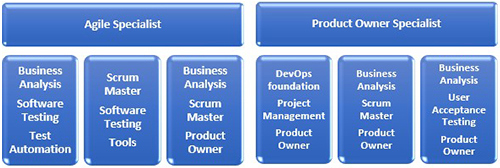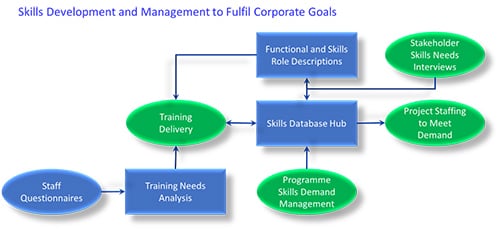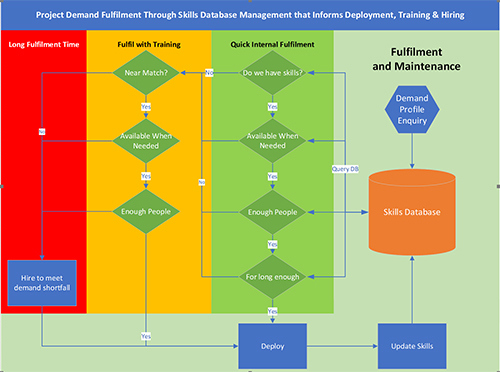Who to train and when, and what skills do we need in our employees to ensure we fulfil our corporate objectives? It’s a well-used question, but is it really the right one to ask as technology advances ever more rapidly than before? From my point of view, it is only half the question; the other half being blending skills and competencies to maximise capability and economies.
A multiskilled workforce
It is increasingly the case that today’s employers must have as well as hire people who can bring multiple skills to the table. Such people add versatility and flexibility to existing teams through primary, secondary and tertiary skills.
Indeed, gone are the days when we could specialise in one area, say ‘user acceptance testing’, and make a life-long career of it. No, it just doesn’t wash anymore on a number of levels, and as technologies and methods develop and become mainstream, then the skills gaps will increase and pose increasing risk to employers and employees alike.
Looking at what might be needed around skills and competencies, there are three key imperatives employers might consider when setting out to deliver complex IT systems:
- What are the skills and quantity that we need to deliver for our given timeline?
- How to imbue our employees with the right skills to meet our deadlines?
- When and when not to hire to acquire skills?
A skills database will provide the answers in both the short and long-term. Building one is very much a collaborative activity that requires input from many different people, and in return many people will benefit. So, let’s look as some key activities we might consider on the route to building and maintaining a business-critical skills database.
Fig 1. Skills Development and Management flow chart (click to view larger image)
Built correctly, a skills database identifies all of the skills an organisation is required to support and will continue to support over time. Equally, it will identify employees, skills, experience and availability that we can use to match against demand to determine:
- If we can meet the skills demand profile at the right time;
- If some can be met;
- If we have people available who can be trained in time;
- What further training is needed and when, for example, demand outstrips supply;
- If skills and training cannot meet demand, then what hiring is needed - be that permanent or associate depends on demand over time and percentage usage. For example, if a skill is needed for 80% of the time then it probably makes sense to hire a permanent person for it, but if the skill is only needed 20% we might hire an associate or train an existing employee who wants to grow to meet the need.
Functional and skills role description
In parallel with skills, it is important that up to date role descriptions are developed and maintained so staff can be assigned to fulfil the demand profile generated by programmes and projects.
It is all very well having a skills list, but the role descriptions are the variable that tell us how they are to be used. For example, we might want someone with ‘performance’ skills. However, the variance might address a number of different role descriptions, such as:
- Performance strategist, which would generally require little product knowledge but be more focused on architecture;
- Performance modelling, which would look at a business day and the typical transactions used, by volume and time of day;
- Performance engineer who knows how to set up and use industry leading tools, to provide assurance that requirements of the strategy and business modelling are met.
So, where as we might think we have only one skill to record, the example shown here shows three different ones that require three different skill sets and experience.
Of further consideration is the hybrid role that encompasses two or more skills. For example, we might consider several key roles on an Agile programme:

Figure 2. Agile Programme detailing different hybrid roles.
Whilst there are many different hybrid roles and near limitless skills combinations, the two above are reasonably representative of the variable skills that may feature in the demand management profile of an Agile programme.
Training needs analysis
This is a task that should need doing only once to set a baseline, following which skills demands and a check on the database inform required updates. It encompasses a number of activities, including:
- Compiling a list of the skills, roles and capability needed;
- Compiling a list of the skills available today;
- Understanding current development plans for staff and their own ambition;
- Conducting a ‘gap analysis’ of the current and future states to inform training / hiring needs.
Once complete, you will have a skills profile and full training plan, balanced against organisational needs that can be re-visited time and time again.
Stakeholder skills needs
The stakeholders are key to building our key skills database, as it is they who will tell us the skills they use on their programmes.
Typically, we might engage them on a number of levels:
- Interview, to determine you capture the skills needed in their function;
- Asking them to complete a questionnaire to list the skills they will deliver.
In general, a combination of the two seems to work best to establish the first cut of our skills database. It is in the interest of stakeholders to participate in compiling a list of skills used and needed in the future, as it is they who will benefit from having a central skills database that will help them staff their programmes and projects - on time and with the experience they need. Once complete, we will have a list of skills, the mode in which they are used and the experience behind them.
Staff questionnaires
Having a list of skills that our key stakeholders require is important, but it is not the last word. Employees will always have skills that employers won’t know about, so it makes sense to record them on our skills database for future use.
Project and skills demand management
Project and programme managers will always have ‘today’ demand for skills - we simply can’t avoid it. However, for the majority of the time, we should get them to think about skills to fill defined roles as early as possible; ideally leaving a gap big enough to rotate, train or hire to meet that demand.
Much like the staff questionnaires, a simply designed process is needed to elicit and fulfil staffing (and possible hiring and/or training) requirements:
- The skills and experience needed;
- When they want it;
- How long they want it for;
- How many they need;
- Any parameters or variances.
Project staffing to meet demand
We have demand from our stakeholders, and we have our skills database, so we are now in a position to get a grip on how to staff and train by addressing the five key statements shown above from the requesting manager:
Figure 3. Fulfilment and Maintenance flow chart. (click to view larger image)
Maintenance is key to success
Like all data driven systems, our ‘skills database’:
- Can only be as good as the data it contains and the updates you apply;
- Is an asset that needs to be managed and updated so that it represents a true reflection of the capability within your organisation.
Managed and updated over time, our ‘skills database’ will provide information that informs decision-making to say “I know the ‘what, when and why’” of:
- The skills I have;
- What I need, when and their availability;
- Who and when I need to train when there is a shortfall;
- When to hire, if skills are not available and cannot be taught in time to meet demand;
- Who to release or retrain as skills become redundant;
The skills database
Build it, use it, maintain it. It will pay dividends in the long-term and provide a return on investment by reducing skills attrition and increasing organisational delivery capability.



















